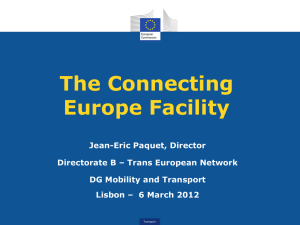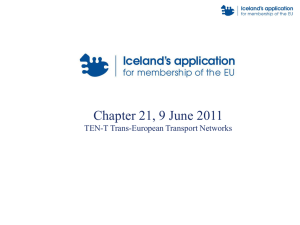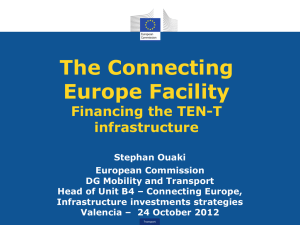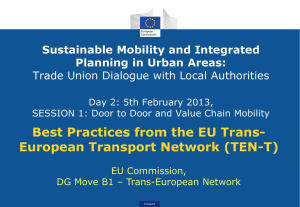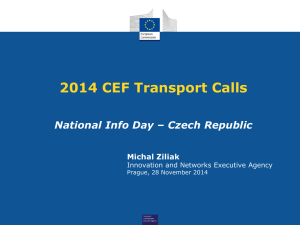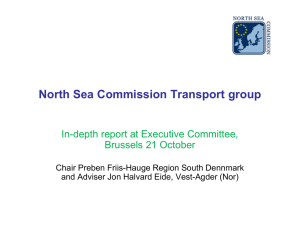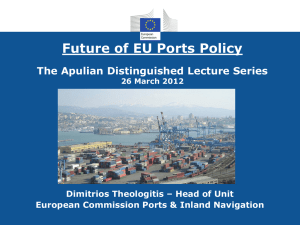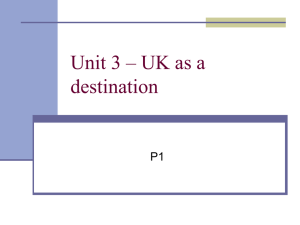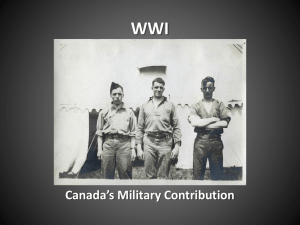core network
advertisement
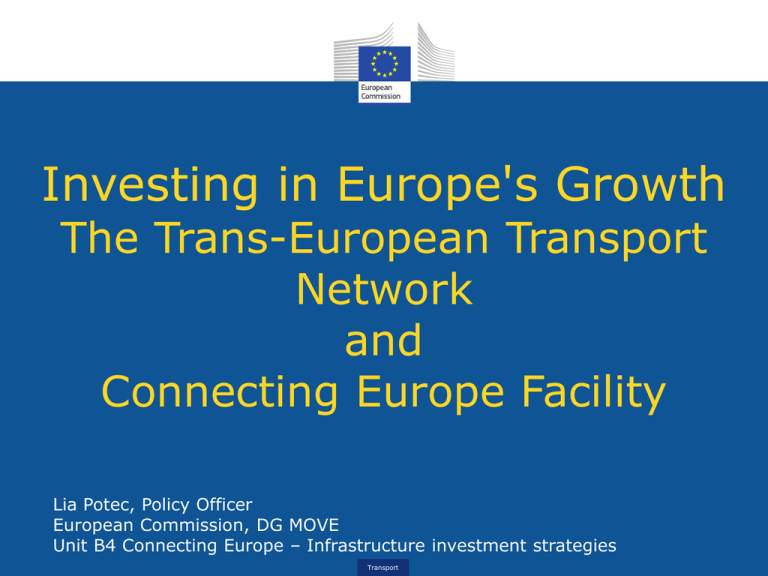
Investing in Europe's Growth The Trans-European Transport Network and Connecting Europe Facility Lia Potec, Policy Officer European Commission, DG MOVE Unit B4 Connecting Europe – Infrastructure investment strategies Transport Overhauling the EU transport sector essential for a sustainable and competitive EU economy Remove bottlenecks and bridge missing links Deploy interoperable traffic management systems Invest in innovative technologies and transport systems Improve transport logistics Render transport services more efficient Transport The Transport “White Paper” 10 goals - to help achieve a competitive and resource efficient system 10 benchmarks - to meet the goal of reducing the GHG emissions by 60% by 2050. 40 concrete initiatives – to be developed over this decade. Transport The Transport “White Paper” By 2030, 30% of road freight over 300 km should shift to other modes such as rail or waterborne transport, and more than 50 % by 2050 By 2050, complete a European high-speed rail network. Triple the length of the existing high-speed rail network by 2030 Maintain a dense railway network in all Member States. By 2050, the majority of medium-distance passenger transport should go by rail. By 2030, a fully functional and EU-wide multimodal TEN-T ‘core network’ with a high-quality and capacity network and a corresponding set of services by 2050 information By 2050, connect all core network airports to the rail (preferably highspeed) network and all core seaports to the rail freight network and, where possible, inland waterway system. Transport The "European Infrastructure Package" Financing framework 2014-2020 Sectoral policy frameworks (setting priorities for 2020, 2030, 2050) Transport The Transport Infrastructure Package Policy framework TEN-T Guidelines Funding framework Connecting Europe Facility Structural and Investment Funds Transport Key elements of the new TEN-T policy • Support implementation of Transport White Paper through new infrastructure policy, including: • • • • New maps Ambitious standards for all infrastructures Common deadlines to achieve network (2030/2050) Corridors and coordinators for implementation • TEN-T Guidelines: Regulation (EU) No 1315/2013 Transport The new TEN-T maps • Dual layer approach based on a single European methodology • Comprehensive network to ensure accessibility to all regions • Core network focusing on the strategically most important parts • Maps contained in Annex I to the Regulation • List of nodes in Annex II • Indicative comprehensive network maps for the neighbouring countries in Annex III Transport TEN-T Network Standards (1/3) Railways (freight), ports and rail-road terminals • Comprehensive Network • • • • Electrification ERTMS 1435mm gauge Connection with freight terminals • Core Network • [see Comprehensive network plus] freight lines (>100 km/h, 750m train length, 22,5t axle load) Transport TEN-T Network Standards (2/3) Roads, ports, rail-road terminals and airports • Comprehensive Network • High quality roads i.e. motorways, expressways, conventional strategic roads • Core Network [see Comprehensive network plus] • Rest areas on motorways all 100 km, including appropriate parking space for commercial road users • Availability of clean fuels Transport TEN-T Network Standards (3/3) Other modes Comprehensive Network Implementation and deployment of telematic applications (RIS, VTMIS, emaritime services, SESAR) Connection of airports and ports to TEN-T network Core Network [see Comprehensive network plus] Availability of clean fuels at airports and ports Connection of ANNEX II ports and airports to TEN-T network by 2030/2050 Transport • TEN-T Comprehensive and Core Network • Inland waterways and ports TEN-T Network Deadlines By 2030: replace the patchwork of priority projects by a single European core network By 2050: develop the comprehensive network as “ground layer” to ensure accessibility and common standards Transport EU TEN-T Core Network Railways (freight), ports and rail-road terminals TEN-T Core Network Corridors and European Coordinators 9 multimodal corridors (defined until 2020*) •Implementation tools •Support the core network implementation •Synchronise investments (Corridor Work Plan), including deployment of new technologies and telematic applications •Alignment with the Rail Freight Corridors •Involvement of stakeholders •European Coordinators also for ERTMS and Motorways of the Sea * Alignment identified in Annex I of the Connecting Europe Facility Regulation Transport Connecting Europe Facility Rules for awarding EU budget support to TEN-T infrastructure projects Eligibility For what, who, how, how much Forms of support • • Grants Financial instruments Objectives & priorities •CEF Regulation: Regulation (EU) No 1316/2013 •Delegated Act: COM(2013) 9690 •Communication: COM(2013)940 •Work Programmes: COM(2014) 1919, COM(2014) 1921 Transport Connecting Europe Facility: budget €33.2 billion in current prices €26.250 billion for transport (Vs ~€8bn for 2007 – 2013) • €14.945 billion for all 28 MS • €11.305 billion for the MS eligible to the Cohesion Fund €1.141 billion for broadband and digital services €5.850 billion for energy infrastructure Transport CEF: Priorities •Modes •Rail, inland waterways, multimodal platforms (ports, rail-road terminals) and intermodal connections •Sections •Missing links, cross-border, bottlenecks •Horizontal •ERTMS, SESAR, other telematic systems (RIS, ITS, e-Maritime...) •Motorways of the Sea, including alternative fuelling (LNG) deployment •New technologies and innovation focusing on decarbonisation, safe and secure infrastructure, ports and airports •Geographical •Core Network, Corridors on the Core Network Transport CEF: Eligibility 80 – 85 % of total budget for projects pre-identified listed in Annex I to the CEF Regulation • Horizontal priorities • Sections on the Core Network Corridors • Other important cross-border and bottleneck sections •15 – 20 % of total budget for • • • • Other projects on the core network Projects on comprehensive network (max 5%) Projects in third countries Financial instruments (10%) Transport CEF Cohesion Envelope: €11.3 bn transferred from the Cohesion Fund Exclusively for transport projects in Member States (MS) eligible for the Cohesion Fund •National envelopes until end 2016 •80-85% of envelope for • core network projects pre-identified in Annex I • Also road cross-border (max. 10% of envelope) •15-20% of envelope for projects • On the core network only • Not on the comprehensive network • Not in third countries • No contribution to financial instruments before 2017 •Common project pipeline for Cohesion Fund and CEF, in line with the transport strategy •Co-funding rates aligned to Cohesion Fund (max. 85%) Transport CEF grants: co-funding rates Types of Projects CEF General Budget CEF Cohesion Envelope (a) Studies (all modes) (b)Works on 50% 85% Cross border Bottleneck Other projects of common interest Cross border Bottleneck Other projects of common interest Inland transport connections to ports and airports (rail and road) Development of ports Development of multi-modal platforms Rail Reduce rail freight noise by retrofitting of existing rolling stock Freight transport services Inland waterways Secure parkings on road core network Motorways of the sea 40% 30% 20% 40% 40% 20% 20% 20% 20% 20% 20% 20% 30% 85% 85% 85% 85% 85% 85% 85% 85% 85% 20% 20% 20% 85% Traffic management systems Cross border road sections 50/20% 50% 20% 10% 85% 85% 85% 85% (core network) New technologies and innovation for all modes of transport 20% 85% SESAR, RIS & VTMIS ERTMS ITS for road Transport CEF in Croatia €159.7 million national Cohesion envelope •Pre-identified projects in Annex I Mediterranean Corridor Rijeka – Zagreb – Budapest Rail – Studies and works (including construction of new track and second track between Rijeka and HU border ) Rijeka Port - Infrastructure upgrading and development, development of multimodal platforms and interconnections Rhine-Danube Corridor Slavonski Brod Port – Studies and works Danube IWW - Studies and works on several sections and bottlenecks; inland waterway ports: multimodal interconnections Sava IWW - Studies and works on several sections and bottlenecks (including cross-border bridge) Other core network sections Dubrovnik – HR/ME border Cross-border road - Works Zagreb – SR border Bottleneck rail – Studies and works Horizontal priorities Transport Complementarity CEF - ESIF CEF - concentrates on ESIF - focus on projects with a high EU added value: projects to remove bottlenecks on cross-border, major bottlenecks, both the core and multimodality, interoperability comprehensive TEN-T on the core network other modes of transport: urban, road, maritime more sustainable modes of transport – rail, IWW, intermodality regional connectivity rehabilitation projects A common and complementary list of projects Member States and Commission – to define early under which support scheme individual TEN-T infrastructure projects should be implemented: CEF, CF or ERDF Consistency with the comprehensive national transport strategy Transport CEF: Centralised management !! EU funds not, not projects Programming via work programmes • Annual and Multiannual Work Programmes Management • Grants – direct management • Financial Instruments – via cooperation agreement with interested entities (e.g. European Investment Bank) Transport CEF: Grant management How to give grant support to a project Transport Financial instruments – Why? • Limited € available: • €26 billion to cover €250 billion in needs! • Limited eligibility for grants under the CEF • Mostly core network • Almost no road or airport infrastructure • Full eligibility for financial instruments • Core & comprehensive TEN-T • Any project eligible under the TEN-T Guidelines • All modes of transport Transport Financial instruments – Projects for what and how • Identifiable revenue streams/commercial benefits and long-term repayment • • • • Motorways with tolls, shadow-tolling, availability schemes Airports development (e.g. new terminal) Ports development (e.g. capacity extension) Alternative fuelling infrastructure and on-board equipment (e.g. LNG on boats) • On-board equipment for traffic management systems (e.g. SESAR) Forms • Equity intruments • • Risk-capital, e.g. Marguerite Fund Investing in equity reduces the need for debt and reduces the level of risks • Debt instruments Guarantees and risk-sharing instruments, e.g. LGTT and Project Bonds • LGTT to support bank lending • Project Bonds to support investment from capital market investors Transport 2014 Work Programmes and Calls Work Programmes • Adopted on 26 March 2014 • Multiannual Work Programme for €11 billion • Annual Work Programme for €1 billion Target date for • Opening calls: September 2014 • Closing calls: end February 2015 Size of the calls will be evaluated on the basis of MS project pipelines In cooperation with MS authorities and DG REGIO, especially for Cohesion MS Transport Thank you for your attention! lia.potec@ec.europa.eu Transport

